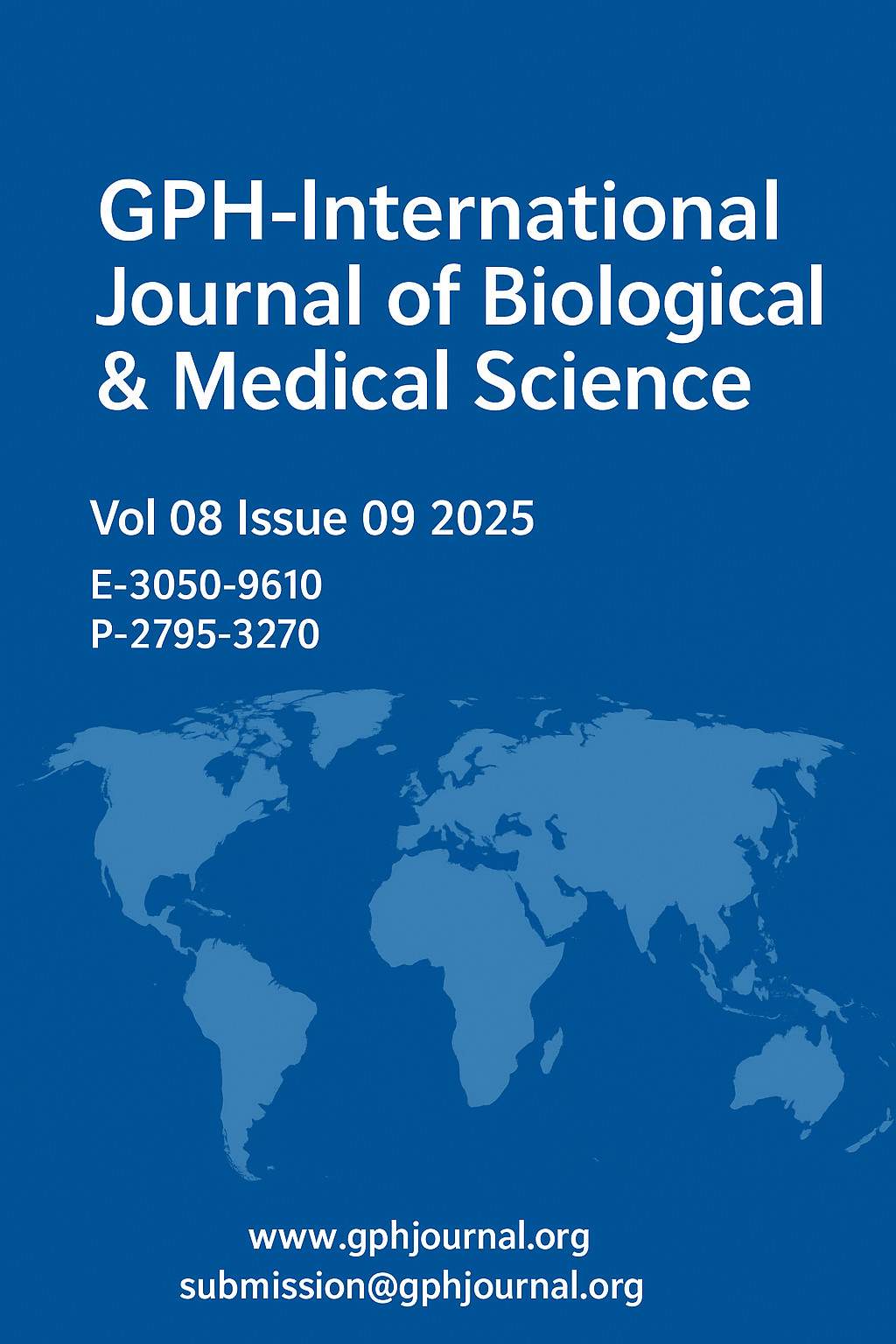Anatomical Variations in the Renal Hilum: Disposition of Vessels and Branching Patterns in Human Cadavers
Abstract
Background: The renal hilum is an important anatomical opening that leads to the kidney. It contains the renal artery, vein, and pelvis. The normal arrangement of the renal vein in front, the artery in the middle, and the pelvis in the back is not always the same. Congenital differences are common and important in medicine. These changes in anatomy affect urological, radiological, and surgical operations, such as nephrectomies and renal transplants. There are more and more kidney procedures happening in South Asia, but there is still not a lot of specific information about renal hilar variations, especially in the Bangladeshi population. Objective: The goal of this study was to look at the several ways that renal hilar structures can branch and change shape in adult Bangladeshi cadavers, see how common they are, and compare the results to data from across the world to help doctors make better decisions. Methodology: We did a descriptive cross-sectional study on 100 kidneys from unclaimed remains (50 right and 50 left). We put kidneys into four age groups: 10–19, 20–39, 40–59, and 60 years or older. We measured morphometric data including weight, length, breadth, and thickness, and then we used the ellipsoid formula to figure out the kidney volume. Histological study of cortical tissue from 5 pairs of kidneys found the size and density of the glomeruli. ANOVA, Student's t-test, Chi-square test, and Pearson correlation were all used to do the statistical analysis. Results: The most common anteroposterior hilar association was VAP (vein, artery, pelvis), which was found in 78% of kidneys. AVP was found in 21% of kidneys, while APV was found in 1%. The renal arteries had different numbers of branches: 72% had four, 19% had three, and 9% had two. The renal veins, on the other hand, always had one branch. Morphometric data showed that the group with the highest kidney volumes was the 20–39 years group (86.0 cm³). The volumes got smaller with age (≥60 years: 71.3 cm³). There were big differences in kidney volume between age groups (p=0.0012), but there were no differences between sides (p=0.19). There was a moderate negative connection between age and kidney volume (r = -0.46, p=0.0008). Conclusion: The renal hilar anatomy of people from Bangladesh is very different, especially when it comes to how the arteries branch and how the hilar structure relates to them. This shows how important it is to do routine preoperative vascular mapping. These results improve anatomical databases, which helps with planning surgeries and lowers the risk of problems during kidney procedures.
Downloads
References
Hassan SS, El-Shaarawy EA, Johnson JC, Youakim MF, Ettarh R. Incidence of variations in human cadaveric renal vessels. Folia Morphologica. 2017;76(3):394-407.
García-Barrios A, Cisneros-Gimeno AI, Celma-Pitarch A, Whyte-Orozco J. Anatomical study about the variations in renal vasculature. Folia Morphologica. 2024;83(2):348-53.
Storch LA. Variations in topography of renal blood vessels (a study witch bodies donated to vilnius university) (Doctoral dissertation, Vilniaus universitetas.).
Dawani P, Mehta V, Kaur A. Anatomical study on variable disposition of structures in the renal hilum. International Journal of Research in Medical Sciences. 2021 Oct;9(10):3039.
Divya C, Ashwini NS, Swaroop Raj BV. Study of arrangement of renal hilar structures in human cadavers.
Chhabra N. Anatomical and embryological study of renal hilum. Int J Anat Res. 2020;8(1.1):7221-25.
Saikia M, Roy RD, Thakuria S. Anatomical Variations in Arrangement of Renal Hilar Structures and its Applied Importance: A Cadaveric Cross-sectional Study among North East Population of India.
Devadas D, Sinha U, Trivedi GN. AN ANATOMICAL STUDY ON HILAR VARIATIONS AND MORPHOMETRIC DIMENSIONS OF HUMAN KIDNEYS.
Shaheen R, Jamil MN. Anatomical pattern and variations of left renal vein. InMedical Forum Monthly 2018 (Vol. 29, No. 3).
Shambharkar SB, Golghate TD, Borate S, Rukhmode VP. Anatomical Study of Renovascular Variations.
García-Touchard A, Maranillo E, Mompeo B, Sañudo JR. Microdissection of the human renal nervous system: implications for performing renal denervation procedures. Hypertension. 2020 Oct;76(4):1240-6.
Varalakshmi KL, Sangeeta M. A cadaveric study on dimensions and hilar structural arrangement of kidney. Int J Anat Res. 2017;5(3.1):4124-28.
Sharma AR, Agarwal RK, Saini H, Khajuria SR, Malik AK. Bilateral Prehilar Branching Of Renal Arteries. Int J Anat Res. 2018;6(3.2):5511-14.
Luz MM, da Silva TM. Anatomy of the retroaortic left renal vein: a study on a human cadaver. Acta Sci Anat. 2022;1:35-8.
Chaudhary S, Gopal UB, Prasanna S, Kumar Giri J. Variation in renal blood supply and its clinical significance-a case report. International Journal of Health Sciences and Research. 2019;9(10):170-4.
Panagouli E, Tsoucalas G, Vasilopoulos A, Evangellos L, Venieratos D, Thomaidis V. Vascular Variations Of The Kidneys: Case Report And Mini Review. Int J Anat Res. 2019;7(2.2):6561-4.
Abdessater M, Alechinsky L, Parra J, Malaquin G, Huot O, Bastien O, Barrou B, Drouin SJ. Anatomical variations of the renal artery based on the surgeon's direct observation: A French perspective. Morphologie. 2022 Feb 1;106(352):15-22.
Trivedi S, Sharma U, Rathore M, John MR, Sharma Sr U, John M. Comprehensive study of arrangement of renal hilar structures and branching pattern of segmental renal arteries: an anatomical study. Cureus. 2023 Jul 19;15(7).
Borthakur D, Kumar R, Dhawan V, Dada R. Bilateral Renal Hilar Nutcracker Phenomenon in a Male Cadaver. Acta Medica Lituanica. 2024 Feb 27;31(1):37.
Vecanova J, Hvizdosova N, Hodorova I. A report on accessory renal arteries incidence in Slovak adults: Cadaveric study and surgical correlation. artery. 2023 Jan 1;3(4):12-3.
Panthier F, Lareyre F, Audouin M, Raffort J. Pelvi-ureteric junction obstruction related to crossing vessels: vascular anatomic variations and implication for surgical approaches. International Urology and Nephrology. 2018 Mar;50(3):385-94.
Mompeó-Corredera B, Hernández-Morera P, Castaño-González I, del Pino Quintana-Montesdeoca M, Mederos-Real N. Regions of the human renal artery: histomorphometric analysis. Anatomy & cell biology. 2022 Sep 30;55(3):330-40.
Gómez FA, Ballesteros LE, Cortés LS. Morphological characterization of the renal vein in pigs (Sus domesticus). Differential analysis with the human renal veins. Eur. J. Anat. 2017 Apr 1;21(2):141-7.
Vijay A, Cooper M, Ghasemian S. Aberrant renal hilar pelvic anatomy in a malrotated kidney. Indian Journal of Urology. 2021 Apr 1;37(2):191-2.
Author(s) and co-author(s) jointly and severally represent and warrant that the Article is original with the author(s) and does not infringe any copyright or violate any other right of any third parties, and that the Article has not been published elsewhere. Author(s) agree to the terms that the GPH Journal will have the full right to remove the published article on any misconduct found in the published article.























